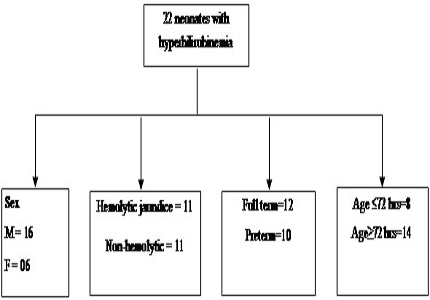Hemodynamic changes during exchange transfusion in early neonatal period
Abstract
Background: Exchange transfusion(ET) has remained the gold standard for rapid lowering of higher bilirubin levels, it is not risk free and mortality rate vary from 0.5 to 3.3%. The present study was carried out to study hemodynamic parameters changes during ET in neonates.
Materials and Methods: 22 neonates who suffered from hyperbilirubinemia and required double volume ET were enrolled in this prospective study. ET was carried out according to standard practice guidelines. Clinical hemodynamic parameters including heart rate, respiratory rate, blood pressure, temperature and ECG, % saturation of oxygen (SpO2) and CVP were monitored continuously before 15 min (pre exchange) during 60-120 min(mid exchange) and after 30 min(post exchange). All data was analysed statistically.
Results: There was significant increase in mean heart rate152.78(19.88),155.12(20.50), mean respiratory rate 46.02(8.87),50.92(6.98) and drop in mean Spo2 91.19(4.17),90.67(4.28) in mid-exchange and post-exchange values respectively as compared to pre exchange values138.72(17.74),36.79(7.58),93.51(3.28) for mean heart rate, respiratory rate and mean SpO2 respectively. There was significant increase in mean diastolic blood pressure values in post-exchange 45.43(13.88) as compared to pre exchange values 41.83(9.80). Mid-exchange value 8.66(2.12) of mean central venous pressure was significantly lower from pre-exchange 10.10(1.92) and post-exchange 9.56(1.98) values. ECG changes did not show any significant changes during ET.
Conclusion: There were significant adverse effects on all hemodynamic clinical parameters. Monitoring of neonate is essential during ET which will prevent complications of ET. Current recommendations for performing ET are based on balance between the risk of encephalopathy and the adverse events related to the procedure holds true.
Downloads
References
2. Hinkes MT, Cloherty JP. Neonatal Hyperbilirubinemia.In: Cloherty JP, Stark AR. Manual of Neonatal Care, 4th edition. USA: Lippincott Williams and Wilkins;1988:175-210.
3. Bhutani VK, Johnson LH, Keren R. Diagnosis and management of hyperbilirubinemia in the term neonate: for a safer first week. Pediatr Clin North Am.2004;51(4):843-61.
4. Ebbesen F, Anderson C, Verder H,Grytter C, Pedersen-Bjergaard L, Petersen JR et al. Extreme hyperbilirubinemia in term and near-term infants in Denmark. Acta Paediatr.2005;94(1):59-64. [PubMed]
5. Hansen TW. Kernicterus in term and near-term infants-the spectre walks again. Acta Paediatr.2000;89(10):1155-57. [PubMed]
6. Sgro M,Campbell D, Shah V. Incidence and causes of severe neonatal hyperbilirubinemia in Canada.CMAJ2006;175(6):587-90. [PubMed]
7. Smitherman H, Stark AR, Bhutani VK. Early recognition of neonatal hyperbilirubinemia and its emergant management. Semin Fetal Neonatel Med.2006;11(3)214-24. [PubMed]
8. Bowman J. The management of haemolytic disease in the fetus and newborn.Semin Perinatol.1997;21(1):39-44. [PubMed]
9. Ip S, Chung M, Kulig J, Obrien R, Sege R, Glicken S et al. An evidence based review of important issues concerning neonatal hyperbilirubinemia. Pediatrics 2004;114(1):e130-53. [PubMed]
10. Badiee Z. Exchange transfusion in neonatal hyperbilirubinemia experience in Isfahan, Iran. Singapore Med J.2007;48(5):421-23. [PubMed]
11. Rehman Abdul, Tahseen Asma Shahzadi, Chaudhary Asma Tauseef.Indications and complications of exchange transfusion. Pakistan Pediatric Journal March 2014;38(1):19-23.
12. Sabzehi MK, Basiri Behnaz, Shokouhi Maryam, Torabian Saadat.Complications of exchange transfusion in hospitalized neonates in two neonatal centres in Hamdan, A five year experience.J Comper Ped.May 2015;6(2):e20587 DOI:10.17795/ComperPed.20587.
13. Panagopoulous G,Valaes T, Doxiadis SA. Morbidity and mortality related to exchange transfusion.J Pediatr.1969;74(2):247-54. [PubMed]
14. Practice parameter management of hyperbilirubinemia in the healthy term newborn.American Academy Of Pediatrics.Provisional committee for quality improvement and subcommittee on hyperbilirubinemia.Pediatrics1994;94(4pt 1):558-65.
15. Rekhas,Guha DK. Neonatal jaundice. In:Guha DK(editor).Neonatology Principles and Practice 2nd edition New Delhi:Jaypee Brothers;1998:420-32.
16. Funato M, Tamal H, Shimada S. Trends in neonatal exchange transfusion at Yodogawa Chirstian Hospital.Acta Paediatr Jpn.1997;39(3):305-8.
17. Hey EN, Kohylinsky S, O`Connel B. Heat losses values during exchange transfusion.Lancet1969;15:335-38.
18. American Academy Of Pediatrics Clinical Practice Guideline. Management of hyperbilirubinemia in the newborn infants 35 or more weeks of gestation.Pediatrics2004;114:297-316.
19. Aranada JV, Sweet AY. Alterations in blood pressure during exchange transfusion.Arch Dis Child.1977;52:545-48. [PubMed]
20. Naik SR, Gupte SC, Merchant RH. Efficacy of exchange transfusion. Indian Pediatr1986;23:501-7. [PubMed]
21. Sproul AM, Smith L. Bilirubin equilibration during exchange transfusion in haemolytic disease of newborn.J Pediatr1964;65(1):12-26.
22. Jackson JC. Adverse events associated with exchange transfusion in healthy and ill newborns. Pediatrics1997;99(5);E7.

Copyright (c) 2017 Author (s). Published by Siddharth Health Research and Social Welfare Society

This work is licensed under a Creative Commons Attribution 4.0 International License.


 OAI - Open Archives Initiative
OAI - Open Archives Initiative


